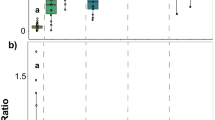Summary
This paper reports on the occurrence of a bimodal growth response by nodulated lucerne to a range of levels of combined nitrogen and considers the role of temperature and genotypic effects in varying this response. The response is characterised by a peak at low levels of combined nitrogen followed by a trough and a further peak at high levels of nitrogen. Host growth rate, rate of development of nitrogen fixing capacity and combined nitrogen uptake are factors implicated in varying this bimodal response.
Any beneficial response to combined nitrogen is restricted to the pre-linear phase of growth.
The need for high legume growth rates to achieve fixation at high soil nitrogen levels is also shown.
Similar content being viewed by others
References
Allos, H. F. and Bartholomew, W. V., Replacement of symbiotic fixation by available nitrogen. Soil Sci. 87, 61–66 (1959).
Gibson, A. H., Physical environment and symbiotic nitrogen fixation. II. Root temperature effects on the relative nitrogen assimilation rate. Australian J. Biol. Sci. 18, 295–310 (1965).
Gibson, A. H., The carbohydrate requirements for symbiotic nitrogen fixation: A whole-plant growth analysis approach. Australian J. Biol. Sci. 19, 499–515 (1966).
Gibson, A. H., Physical environment and symbiotic nitrogen fixation. IV. Factors affecting the early stages of nodulation. Australian J. Biol. Sci. 20, 1087–1104 (1967).
Gibson, A. H., Physical environment and symbiotic nitrogen fixation. V. Effect of time or exposure to unfavourable root temperatures. Australian J. Biol. Sci. 20, 1105–1117 (1967).
Hardy, R. W. F., Holsten, R. D., Jackson, E. E. and Burns, R. C., The acetylene-ethylene assay for N2 fixation: Laboratory and field evaluation. Plant Physiol. 43, 1185 (1968).
Holmes, D. P., Nitrogen uptake and distribution. Welsh Plant Breeding Sta., p. 28 (1964).
Lycklama, J. C., The absorption of ammonium and nitrate by perennial ryegrass. Acta Botan. Neerlandica 12, 361–423 (1963).
Moustofa, E., Ball, R. and Field, T. R. O., The use of acetylene reduction to study the effect of nitrogen fertilizer and defoliation on nitrogen fixation by fieldgrown white clover. New Zealand J. Agr. Research 12, 691–6 (1969).
Munns, D. N., Nodulation of Medicago sativa in solution culture. II. Compensating effects of nitrate and of prior nodulation. Plant and Soil 28, 246–257 (1968).
Oghogharie, C. G. O. and Pate, J. S., The nitrate stress syndrome of the nodulated field pea (Pisum arvense L.). Techniques for measurement and evaluation in physiological terms. Plant and Soil Special Volume, 185–202 (1971).
Small, J. G. C. and Joffe, A., Physiological studies on the genus Trilolium with special reference to the South African species. II. Influence of root temperature on growth, nodulation and symbiotic nitrogen fixation. South African J. Agr. Sci. 11, 41–56 (1968).
Author information
Authors and Affiliations
Rights and permissions
About this article
Cite this article
Hoglund, J.H. Bimodal response by nodulated legumes to combined nitrogen. Plant Soil 39, 533–545 (1973). https://doi.org/10.1007/BF00264171
Received:
Issue Date:
DOI: https://doi.org/10.1007/BF00264171




